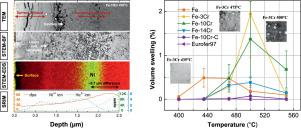Acta Materialia ( IF 8.3 ) Pub Date : 2021-01-19 , DOI: 10.1016/j.actamat.2021.116660 Yan-Ru Lin , Arunodaya Bhattacharya , Da Chen , Ji-Jung Kai , Jean Henry , Steven J. Zinkle

|
Fe-Cr ferritic-martensitic (FM) steels are promising structural material candidates for fusion and advanced fission reactors due to their attractive mechanical properties and volumetric swelling resistance. However, significant discrepancies exist regarding the effect of solutes and irradiation temperature on cavity swelling under ion versus neutron irradiation conditions. In this study, simultaneous dual ion irradiations (8 MeV Ni3+ ions and energy-degraded 3.5 MeV He2+ ions) were used to quantify the cavity swelling behavior in ultra-high purity Fe and Fe-Cr alloys (3-14 wt.% Cr), Fe-10 wt.% Cr-780 wt.ppm C, and Eurofer97 FM steel. The irradiations were conducted over a wide temperature range (400-550°C) with a mid-range dose of ~30 displacements per atom (dpa) and 0.1 appm/dpa He implantation rate. Using state-of-the-art transmission electron microscopy (TEM), we reveal that pure Fe has a ~50°C lower peak swelling temperature difference than Fe-Cr alloys, which is attributed to higher vacancy mobility in pure Fe. Chromium solute appears to strongly suppress cavity swelling in Fe-Cr alloys for temperatures below ~470°C, but seems to have little effect or slightly enhances swelling above ~470°C. Cavities were observed in all the irradiated samples between 400-550°C. This indicates that the narrow temperature range of observable cavities reported in prior ion irradiated Fe-Cr ferritic alloy studies is likely an artifact associated with the use of low ion energies (<5 MeV), which leads to pronounced near-surface and implanted ion effects that suppress cavity swelling even at midrange depths (particularly at high temperatures).
中文翻译:

双离子辐照铁和铁铬铁素体合金中随温度变化的型腔膨胀
Fe-Cr铁素体-马氏体(FM)钢因其有吸引力的机械性能和抗体积膨胀性而成为有前途的聚变和高级裂变反应堆的结构材料候选材料。但是,在离子对中子辐照条件下,溶质和辐照温度对空腔溶胀的影响存在显着差异。在这项研究中,同时进行双离子辐照(8 MeV Ni 3+离子和能量降解的3.5 MeV He 2+离子)被用于量化超高纯度Fe和Fe-Cr合金(3-14 wt。%Cr),Fe-10 wt。%Cr-780 wt.ppm C和Eurofer97 FM钢中的腔体膨胀行为。辐射是在宽温度范围(400-550°C)内进行的,中间剂量约为每原子位移30 dpa(dpa)和0.1 appm / dpa He注入速率。使用最新的透射电子显微镜(TEM),我们发现纯铁比Fe-Cr合金的溶胀峰温差低约50°C,这归因于纯铁的空位迁移率更高。铬溶质似乎可在低于约470°C的温度下强烈抑制Fe-Cr合金中的溶胀,但似乎对溶胀几乎没有影响,或略微增强了470°C以上的溶胀。在400-550℃之间的所有辐照样品中都观察到了空腔。











































 京公网安备 11010802027423号
京公网安备 11010802027423号